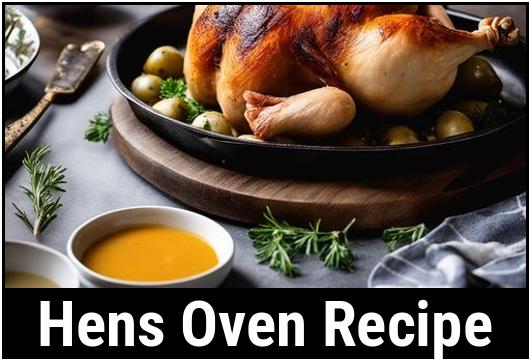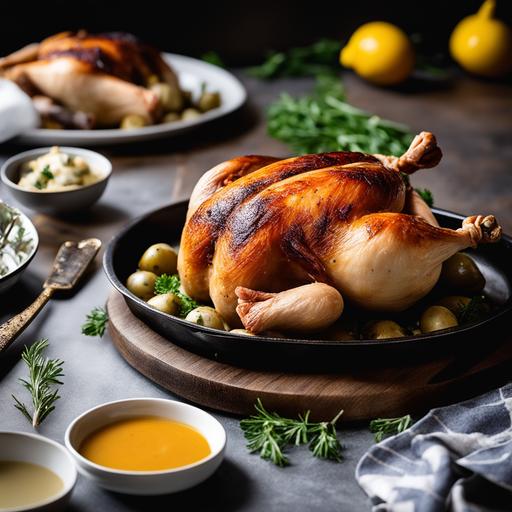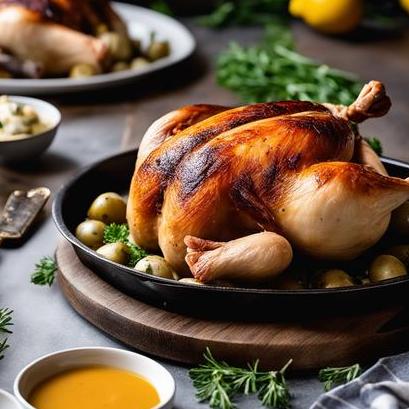
Hens Oven Recipe: A Delicate Delight For Every Food Enthusiast
Cooking is an art that allows us to explore different flavors, experiment with ingredients, and indulge in delectable dishes. If you are looking for a delightful and impressive meal to prepare for your loved ones, a hens oven recipe might just be the perfect choice. This comprehensive and in-depth article will guide you through the marvelous world of cooking hens, covering various aspects such as food science, culinary details, selection, cleaning, preparation, tips, variations, doneness checks, recipes, and much more. So let’s embark on this culinary adventure together!
Understanding the Food Science behind Hens
Hens, also known as broiler chickens, are young birds between six to eight weeks old. They have tender meat, a mild flavor, and a delicate texture, making them a popular choice for many dishes.
When cooking hens, it is crucial to understand the food science behind it. Hens have relatively low amounts of connective tissue and fat compared to older chickens, which can result in dryness if not prepared correctly. This is why oven cooking methods are preferred, as they help retain moisture and ensure a tender, juicy final product.
Selecting the Perfect Hen
Selecting the perfect hen is the first step towards a successful culinary journey. When choosing hens, look for ones that have a plump appearance, moist skin, and a light pink color. Avoid hens with any signs of discoloration, off-putting odors, or excessive blemishes.
Opt for hens that weigh around 2 to 4 pounds (900g to 1800g) for ideal portion sizes. Remember, hens are smaller compared to regular chickens, so adjust your quantities accordingly to ensure everyone gets a satisfying meal.
Cleaning and Preparing the Hen

Before you start preparing the hen, it is essential to clean it thoroughly to ensure food safety and remove any unwanted residues. Follow these steps:
-
Rinse the hen under cold water, inside and out, ensuring all cavities are clear of any debris.
-
Pat the hen dry with paper towels to remove excess moisture.
-
Season the hen with salt and pepper, both inside and outside, to enhance the flavor.
Tips for a Perfectly Cooked Hen
Cooking a hen to perfection requires attention to detail and a few expert tips. Consider the following recommendations to achieve a restaurant-worthy result:
-
Preheating the oven is crucial. Ensure the oven reaches the desired temperature before placing the hen inside.
-
Use a roasting rack or elevate the hen on a bed of vegetables like carrots and onions to prevent it from sitting in its juices. This keeps the skin crispy and prevents it from getting soggy.
-
Basting the hen with melted butter or olive oil during cooking will infuse moisture, improve browning, and enhance the flavors.
-
To keep the hen moist, consider placing a sprig of rosemary or thyme inside the cavity. These aromatic herbs will lend a subtle fragrance, elevating the overall taste.
Variations to Elevate the Flavor
While a classic roasted hen is delightful on its own, experimenting with variations can take your dish to new heights. Consider these flavor-enhancing ideas:
Citrus Infusion
Squeeze fresh lemon or orange juice over the hen before roasting to infuse it with a tangy, vibrant flavor. The citrusy notes will complement the mild taste of the hen and awaken your taste buds.
Herb Butter Rub
Create an herb-infused butter by combining softened butter with chopped fresh herbs like thyme, rosemary, and sage. Rub this mixture all over the hen before roasting. The herb butter will form a crispy, flavorful crust, delighting your senses with every bite.
Garlic and Herb Stuffing
Elevate your hen by adding a savory stuffing. Mix breadcrumbs, minced garlic, chopped fresh herbs, such as parsley and basil, and a touch of melted butter. Stuff this mixture inside the hen’s cavity before roasting, allowing the flavors to meld together.
Doneness Checks and Cooking Times

Determining the doneness of your hen is crucial to achieve perfect results. Follow these guidelines for a safe and tasty experience:
-
Internal Temperature – Invest in a reliable meat thermometer to monitor the internal temperature of the hen. Cook until the thickest part of the thigh reads 165°F (74°C). This ensures the poultry reaches the appropriate temperature for safe consumption.
-
Juice Color and Consistency – Another visual indicator of doneness is the color and consistency of the juices. When the hen is fully cooked, the juices should run clear, without any hints of blood or pinkness. Additionally, the meat should be tender and should easily separate from the bone.
To help you estimate cooking times, here’s a general guideline for a 3-pound (1.4 kg) hen roasted at 350°F (175°C):
-
25 minutes per pound (450g), or
-
Approximately 75 minutes in total.
Please note that cooking times may vary depending on the size, individual oven, and other factors. Always rely on internal temperature and other doneness indicators for accurate results.
Overcooking vs. Undercooking
When cooking hens, striking the perfect balance between overcooking and undercooking is essential. Each situation can have different effects on the texture and taste of the meat.
Overcooking: Overcooked hen may result in dry, tough meat. The lack of moisture makes it less enjoyable to eat. Pay close attention to the recommended cooking times and internal temperature to avoid overcooking. Remember, practice makes perfect, and slight adjustments may be needed based on personal preferences and individual ovens.
Undercooking: Consuming undercooked poultry poses potential health risks due to harmful bacteria. Ensure the hen reaches an internal temperature of 165°F (74°C) to eliminate any bacterial concerns. Undercooked hen will have translucent or pinkish juices, indicating it needs more cooking time.
Classic Hens Oven Roast Recipe
Here’s a classic hens oven roast recipe to help you dive into this delightful cooking experience:
Ingredients:
-
2 hens, approximately 2.5 pounds (1.1 kg) each
-
Salt and pepper, to taste
-
4 tablespoons (56g) melted butter or olive oil
-
Fresh herbs for garnish (optional)
Instructions:
-
Preheat the oven to 350°F (175°C).
-
Rinse the hens under cold water, inside and out, and pat them dry with paper towels.
-
Season the hens generously with salt and pepper, both inside and outside.
-
Brush the melted butter or olive oil all over the hens, ensuring a thin, even coating.
-
Place the hens breast-side up on a roasting rack or bed of vegetables in a roasting pan.
-
Roast the hens for approximately 75 minutes, or until the thickest part of the thigh reaches an internal temperature of 165°F (74°C).
-
Let the hens rest for 10 minutes before carving.
-
Garnish with fresh herbs, if desired, and serve with your favorite sides.
Exploring Further Possibilities
Now that you have mastered the classic hens oven roast recipe, don’t be afraid to venture into the world of culinary creativity. Experiment with additional seasonings, stuffings, glazes, and cooking techniques to bring unique flavors to your table. Remember, cooking is an art, and each chef adds their personal touch.
With a little practice and exploration, you will soon become a hens cooking expert, impressing your loved ones with delightful, succulent meals fit for any occasion.
Enjoy your hens oven recipe journey and happy cooking!
Sources
FAQS On Hens Oven Recipe
What Ingredients Do I Need For A Tasty Hens Oven Recipe?
You will need hens, olive oil, garlic, thyme, rosemary, salt, pepper, and your choice of vegetables such as carrots, potatoes, and onions.
How Long Should I Bake Hens In The Oven?
Depending on the size of the hens, they should be baked in the oven at 375°F for approximately 1 to 1.5 hours, or until the internal temperature reaches 165°F.
Can I Marinate The Hens Before Baking Them In The Oven?
Yes, marinating the hens in a mixture of olive oil, garlic, thyme, rosemary, salt, and pepper for a few hours before baking will enhance the flavor.
What Is The Best Way To Ensure The Hens Are Fully Cooked In The Oven?
The best way to ensure the hens are fully cooked is to use a meat thermometer to check the internal temperature. Once it reaches 165°F, the hens are ready to be taken out of the oven.
How Should I Arrange The Hens And Vegetables In The Baking Dish?
Place the hens in the center of the baking dish and surround them with the chopped vegetables. This will allow the hens to cook evenly and infuse the vegetables with flavor.


